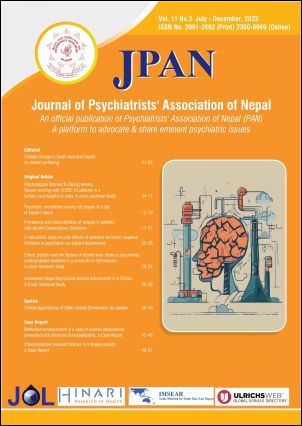Prevalence and characteristics of relapse in patients with Alcohol Dependence Syndrome
DOI:
https://doi.org/10.3126/jpan.v11i2.57633Keywords:
Alcohol dependence, Abstinence, Relapse, TreatmentAbstract
Background: Relapse is an important but difficult phase of the management of alcohol dependence syndrome (ADS).
Objective: To study the prevalence and characteristics of relapse in patients with ADS.
Methods:This is a descriptive cross-sectional study on the patients with ADS presenting at the Department of Psychiatry, Patan Academy of Health Sciences, for the period of one year (June 2016 - May 2017). Data on the demographic and relapse characteristics were collected. Data were entered and analyzed in Microsoft Excel (MS Office 365, Microsoft Corporation, Washington, United States). Numerical variables were summarized with the median (Inter-Quartile Range [IQR]) and the categorical variables with proportions.
Results: Altogether, 105 patients with ADS were studied, among which 59 patients had a relapse (56.1%). All of them were male with a median age of 42 years (Interquartile range (IQR) 35 to 52). The majority were married (55, 93.22%), manual labor as an occupation (32, 54.24%), were Janjati by ethnicity (37, 62.71%), and had received secondary education (19, 32.20%). The median age of starting alcohol consumption was 18 years (IQR 15 to 20) and the median duration of consumption was 22 years (IQR 15 to 30). The most common reason for relapse was peer pressure (25, 42.37%). The majority had relapsed once before (26, 44.07%). Mostly relapsed after abstinence of 1 to 3 months (22, 37.29%) and abstinence maintained by self-motivation (30, 50.85%). Comorbidity and family history of substance use was present in higher proportions.
Conclusion: A high rate of relapse was found in our patients with peer pressure as the most common reason for the relapse.
Downloads
Downloads
Published
How to Cite
Issue
Section
License
Copyright (c) 2022 Journal of Psychiatrists' Association of Nepal

This work is licensed under a Creative Commons Attribution 4.0 International License.
This license enables reusers to distribute, remix, adapt, and build upon the material in any medium or format, so long as attribution is given to the creator. The license allows for commercial use.




